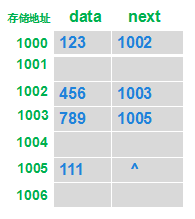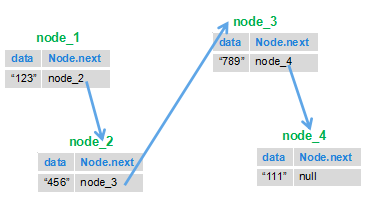【数据结构】链表的原理及java实现
2018-04-02 14:56
405 查看
一:单向链表基本介绍
链表是一种数据结构,和数组同级。比如,Java中我们使用的ArrayList,其实现原理是数组。而LinkedList的实现原理就是链表了。链表在进行循环遍历时效率不高,但是插入和删除时优势明显。下面对单向链表做一个介绍。单向链表是一种线性表,实际上是由节点(Node)组成的,一个链表拥有不定数量的节点。其数据在内存中存储是不连续的,它存储的数据分散在内存中,每个结点只能也只有它能知道下一个结点的存储位置。由N各节点(Node)组成单向链表,每一个Node记录本Node的数据及下一个Node。向外暴露的只有一个头节点(Head),我们对链表的所有操作,都是直接或者间接地通过其头节点来进行的。
上图中最左边的节点即为头结点(Head),但是添加节点的顺序是从右向左的,添加的新节点会被作为新节点。最先添加的节点对下一节点的引用可以为空。引用是引用下一个节点而非下一个节点的对象。因为有着不断的引用,所以头节点就可以操作所有节点了。
下图描述了单向链表存储情况。存储是分散的,每一个节点只要记录下一节点,就把所有数据串了起来,形成了一个单向链表。

节点(Node)是由一个需要储存的对象及对下一个节点的引用组成的。也就是说,节点拥有两个成员:储存的对象、对下一个节点的引用。下面图是具体的说明:

二、单项链表的实现
package com.zjn.LinkAndQueue;
/**
* 自定义链表设计
*
* @author zjn
*
*/
public class MyLink {
Node head = null; // 头节点
/**
* 链表中的节点,data代表节点的值,next是指向下一个节点的引用
*
* @author zjn
*
*/
class Node {
Node next = null;// 节点的引用,指向下一个节点
int data;// 节点的对象,即内容
public Node(int data) {
this.data = data;
}
}
/**
* 向链表中插入数据
*
* @param d
*/
public void addNode(int d) {
Node newNode = new Node(d);// 实例化一个节点
if (head == null) {
head = newNode;
return;
}
Node tmp = head;
while (tmp.next != null) {
tmp = tmp.next;
}
tmp.next = newNode;
}
/**
*
* @param index:删除第index个节点
* @return
*/
public boolean deleteNode(int index) {
if (index < 1 || index > length()) {
return false;
}
if (index == 1) {
head = head.next;
return true;
}
int i = 1;
Node preNode = head;
Node curNode = preNode.next;
while (curNode != null) {
if (i == index) {
preNode.next = curNode.next;
return true;
}
preNode = curNode;
curNode = curNode.next;
i++;
}
return false;
}
/**
*
* @return 返回节点长度
*/
public int length() {
int length = 0;
Node tmp = head;
while (tmp != null) {
length++;
tmp = tmp.next;
}
return length;
}
/**
* 在不知道头指针的情况下删除指定节点
*
* @param n
* @return
*/
public boolean deleteNode11(Node n) {
if (n == null || n.next == null)
return false;
int tmp = n.data;
n.data = n.next.data;
n.next.data = tmp;
n.next = n.next.next;
System.out.println("删除成功!");
return true;
}
public void printList() {
Node tmp = head;
while (tmp != null) {
System.out.println(tmp.data);
tmp = tmp.next;
}
}
public static void main(String[] args) {
MyLink list = new MyLink();
list.addNode(5);
list.addNode(3);
list.addNode(1);
list.addNode(2);
list.addNode(55);
list.addNode(36);
System.out.println("linkLength:" + list.length());
System.out.println("head.data:" + list.head.data);
list.printList();
list.deleteNode(4);
System.out.println("After deleteNode(4):");
list.printList();
}
}12
3
4
5
6
7
8
9
10
11
12
13
14
15
16
17
18
19
20
21
22
23
24
25
26
27
28
29
30
31
32
33
34
35
36
37
38
39
40
41
42
43
44
45
46
47
48
49
50
51
52
53
54
55
56
57
58
59
60
61
62
63
64
65
66
67
68
69
70
71
72
73
74
75
76
77
78
79
80
81
82
83
84
85
86
87
88
89
90
91
92
93
94
95
96
97
98
99
100
101
102
103
104
105
106
107
108
109
110
111
112
113
114
115
116
117
118
119
120
121
122
123
124
125
126
127
128
三、链表相关的常用操作实现方法
1. 链表反转/**
* 链表反转
*
* @param head
* @return
*/
public Node ReverseIteratively(Node head) {
Node pReversedHead = head;
Node pNode = head;
Node pPrev = null;
while (pNode != null) {
Node pNext = pNode.next;
if (pNext == null) {
pReversedHead = pNode;
}
pNode.next = pPrev;
pPrev = pNode;
pNode = pNext;
}
this.head = pReversedHead;
return this.head;
}12
3
4
5
6
7
8
9
10
11
12
13
14
15
16
17
18
19
20
21
22
2. 查找单链表的中间节点采用快慢指针的方式查找单链表的中间节点,快指针一次走两步,慢指针一次走一步,当快指针走完时,慢指针刚好到达中间节点。
/**
* 查找单链表的中间节点
*
* @param head
* @return
*/
public Node SearchMid(Node head) {
Node p = this.head, q = this.head;
while (p != null && p.next != null && p.next.next != null) {
p = p.next.next;
q = q.next;
}
System.out.println("Mid:" + q.data);
return q;
}12
3
4
5
6
7
8
9
10
11
12
13
14
15
3. 查找倒数第k个元素采用两个指针P1,P2,P1先前移K步,然后P1、P2同时移动,当p1移动到尾部时,P2所指位置的元素即倒数第k个元素 。
/**
* 查找倒数 第k个元素
*
* @param head
* @param k
* @return
*/
public Node findElem(Node head, int k) {
if (k < 1 || k > this.length()) {
return null;
}
Node p1 = head;
Node p2 = head;
for (int i = 0; i < k; i++)// 前移k步
p1 = p1.next;
while (p1 != null) {
p1 = p1.next;
p2 = p2.next;
}
return p2;
}12
3
4
5
6
7
8
9
10
11
12
13
14
15
16
17
18
19
20
21
4. 对链表进行排序
/**
* 排序
*
* @return
*/
public Node orderList() {
Node nextNode = null;
int tmp = 0;
Node curNode = head;
while (curNode.next != null) {
nextNode = curNode.next;
while (nextNode != null) {
if (curNode.data > nextNode.data) {
tmp = curNode.data;
curNode.data = nextNode.data;
nextNode.data = tmp;
}
nextNode = nextNode.next;
}
curNode = curNode.next;
}
return head;
}12
3
4
5
6
7
8
9
10
11
12
13
14
15
16
17
18
19
20
21
22
23
5. 删除链表中的重复节点
/**
* 删除重复节点
*/
public void deleteDuplecate(Node head) {
Node p = head;
while (p != null) {
Node q = p;
while (q.next != null) {
if (p.data == q.next.data) {
q.next = q.next.next;
} else
q = q.next;
}
p = p.next;
}
}12
3
4
5
6
7
8
9
10
11
12
13
14
15
16
17
6. 从尾到头输出单链表,采用递归方式实现
/**
* 从尾到头输出单链表,采用递归方式实现
*
* @param pListHead
*/
public void printListReversely(Node pListHead) {
if (pListHead != null) {
printListReversely(pListHead.next);
System.out.println("printListReversely:" + pListHead.data);
}
}12
3
4
5
6
7
8
9
10
11
7. 判断链表是否有环,有环情况下找出环的入口节点
/**
* 判断链表是否有环,单向链表有环时,尾节点相同
*
* @param head
* @return
*/
public boolean IsLoop(Node head) {
Node fast = head, slow = head;
if (fast == null) {
return false;
}
while (fast != null && fast.next != null) {
fast = fast.next.next;
slow = slow.next;
if (fast == slow) {
System.out.println("该链表有环");
return true;
}
}
return !(fast == null || fast.next == null);
}
/**
* 找出链表环的入口
*
* @param head
* @return
*/
public Node FindLoopPort(Node head) {
Node fast = head, slow = head;
while (fast != null && fast.next != null) {
slow = slow.next;
fast = fast.next.next;
if (slow == fast)
break;
}
if (fast == null || fast.next == null)
return null;
slow = head;
while (slow != fast) {
slow = slow.next;
fast = fast.next;
}
return slow;
}
相关文章推荐
- 【数据结构】链表的原理及java实现
- 【数据结构】链表的原理及java实现
- 【数据结构】链表的原理及java实现
- 【Java数据结构】2.1单链表的实现
- java实现 数据结构:链表、 栈、 队列、优先级队列、哈希表
- 数据结构链表(java版)的实现和思考
- 【Java数据结构】2.4单循环链表的实现
- 单链表-数据结构-java实现
- Java HashMap 实现原理及数据结构
- 数据结构(三):链表的Java实现
- 数据结构java实现之双端链表
- 数据结构Java实现04----循环链表、仿真链表
- Java数据结构之双端链表原理与实现方法
- Java HashSet 实现原理及数据结构
- Java中链表、堆栈、队列、二叉树、散列表等数据结构的实现
- 数据结构:二叉树的二叉链表存储--Java实现
- 使用java实现双向链表数据结构
- 数据结构学习----线性表的链式表示之升序排序的单链表(Java实现)
- java实现 数据结构:链表、 栈、 队列、优先级队列、哈希表
- Java实现单链表数据结构
